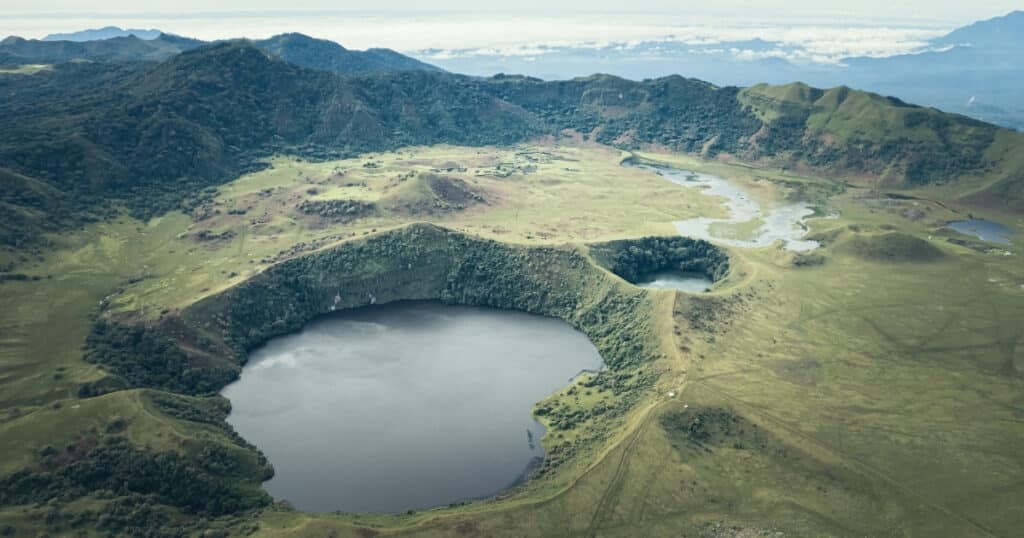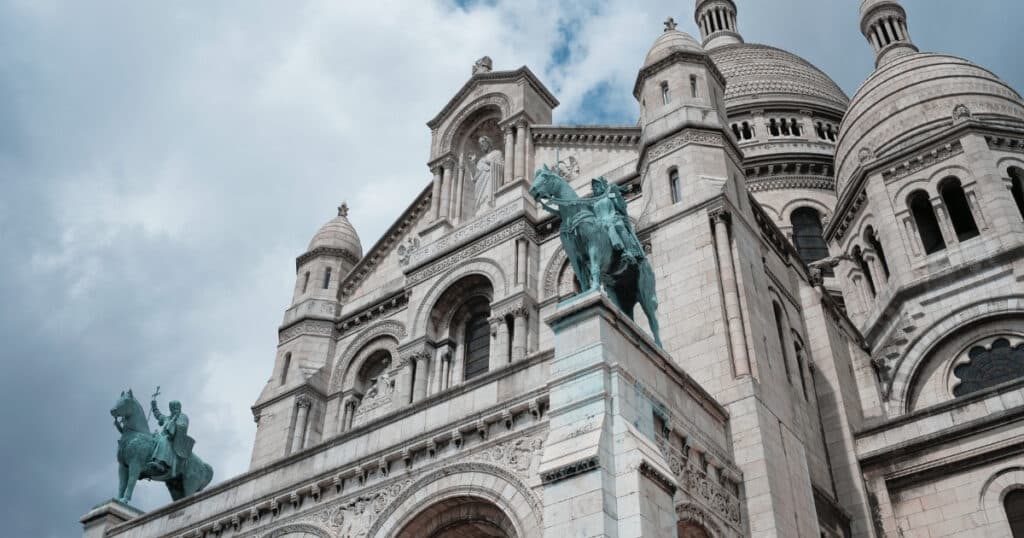D01 » Dschang, First contact with western Cameroon
An adventure in Cameroon, Africa in miniature. We explored the majestic Ekom-Nkam falls, delved into history at Dschang’s Museum of Civilization.
Western Cameroon called to us, with its rich heritage woven from the Bamileke and Bamum cultures – enchanting places like Dschang, Bafoussam, and Foumban.
Our journey began at dawn, each sunrise fueling our eagerness to embrace the wonders that lay ahead. Our first stop: the breathtaking Ekom-Nkam waterfalls, a spectacle of nature’s grandeur that left us speechless.
From there, we ventured to Dschang, a city brimming with history and culture, exemplified by its revered Museum of Civilizations. Our day culminated in Tockem, where we found respite in a guesthouse, a testament to ecotourism and harmony with nature, born from the vision of a Bamileke chief.
Our expedition took a meaningful turn in Douala with the arrival of Serge from Tourismo Cameroon. He became our guide, offering invaluable insights as we traversed the western tapestry of this proud nation. While I’ve explored western Cameroon’s splendor before, this time, I embraced the role of a son, prioritizing my parents’ experience. Enlisting a professional guide felt like the wisest path, ensuring this journey would be a tapestry of shared learning and rich moments for all of us.
Ekom-Nkam Waterfalls: Nature’s Masterpiece
A three-hour journey along a challenging road led us to a moment of pure liberation as we stretched our limbs and inhaled the invigorating air of the forest.
Bathed in nature’s grandeur, my parents’ eyes sparkled with childlike wonder, captivated by the spectacle before them.
For those who follow my blog, you might recall my previous musings on these regal waterfalls, cascading from a height of over 80 meters. If you haven’t yet, I invite you to delve into that story and explore the soul of this extraordinary place.
Our two hours there were transformative, filled with conversations that flowed as freely as the rivers below. We spoke of the waterfalls’ breathtaking beauty and the profound geological forces that shaped this region over millennia.
This experience forged a deeper connection for my parents with the waterfalls I often described. They also discovered the legendary “Tarzan’s Tree,” a silent sentinel from the 1984 film, a testament to the enduring power of storytelling and its intersection with the natural world.
In the shadow of the cascading waters, we stumbled upon a cocoa field, a hidden treasure trove. I had the pleasure of introducing my parents to the cocoa pods, the origin of the beans that magically transform into the chocolate we all love. The tree itself, laden with promise, seemed to whisper secrets of future delights.
For those unfamiliar with the wonders of tropical agriculture, like my parents, this was a captivating revelation. Cocoa, in particular, held a special fascination, as it’s the source of a beloved treat.
As midday approached, we bid farewell to this natural sanctuary and continued our journey towards Dschang, where the Museum of Civilizations awaited, a portal into history and culture. The day held one more surprise: a temporary exhibition where artists converged to share their creations, an unexpected bonus that added another layer of richness to our experience.
Dschang: Where Culture and Youth Converge
Nestled within the Bamileke highlands, Dschang is a city etched in my travel memories. Reaching it requires traversing a serpentine road that hugs the cliffside, revealing breathtaking views of the valley below.
This road, as awe-inspiring as it is challenging, tests the traveler’s spirit. We navigated it safely, each turn unveiling new layers of the landscape’s majesty.
Dschang, energized by its vibrant student population, pulses with youthful dynamism. Since 1993, the city has been a center of learning, home to faculties spanning Agricultural Sciences, Economic Sciences and Business Management, Humanities, Law and Political Sciences, and Sciences. Each faculty contributes to Dschang’s rich intellectual and cultural tapestry.
Our exploration included a delightful pause at the Fosso restaurant, nestled at the foot of the Alliance Francaise, where we savored a meal that nourished both body and soul.
With our appetite for knowledge piqued, we ventured into the Museum of Civilisations, a sanctuary of history and heritage, ready to immerse ourselves in the stories and artifacts that shape this enchanting region.
Dschang’s Museum of Civilizations: A Cultural Gateway
Just before the edge of the city, along the road to Bafoussam, stands a striking building that embodies the essence of Bamileke artistry. This modern structure, adorned with blue patterns, vividly depicts stylized animals emblematic of Western Cameroon.
This architectural gem is the Museum of Civilizations, a key part of the ambitious “Road of Chiefdoms” project. Since its opening on November 20, 2010, the museum, a collaboration between Dschang and Nantes, France, has served as a gateway to Cameroon’s rich cultural and historical heritage. It offers a unique opportunity to understand the nation’s diverse people and cultures.
Inside, the museum unfolds into sections dedicated to Cameroon’s four primary cultural groups: the forest dwellers, the water communities, the grassland inhabitants, and the peoples of northern Cameroon.
Each section presents a vivid tableau: replicas of traditional huts, tools, and landscapes, accompanied by informative panels that illuminate the beliefs, customs, and rituals of these diverse communities. The museum is a treasure trove of knowledge for anyone intrigued by Cameroon’s cultural landscape.
I highly recommend engaging a museum guide to bring the exhibits to life with detailed explanations and captivating stories. While our guide’s name escapes me, her passion and expertise left a lasting impression. If you’re fortunate, you might find her at the entrance.
To fully appreciate the museum’s wealth of information, allocate at least one and a half to two hours. Due to our late arrival, we were pressed for time and couldn’t delve as deeply as we wished into the wealth of knowledge it offered.
As we departed the museum, our cultural journey continued at the Alliance Francaise, where a temporary exhibition beckoned, promising further artistic exploration.
The “Re-connect” Exhibition: Art and Academia in Harmony
Upon arriving a few hours earlier, we were greeted by a delightful surprise: a temporary exhibition at the Alliance Francaise, an unexpected discovery as I was unaware of its presence in the city.
This exhibition, a testament to the interconnectedness of art and education, was conceived by the university’s Department of Applied Foreign Languages. They wove together a thought-provoking theme: “Re-connecting Objects, Knowledge and/with Subjects”.
An article from the University of Dschang’s website illuminated the exhibition’s origins, revealing the motivations and aspirations behind this artistic endeavor. It was a moment of insight, highlighting the convergence of intellectual pursuits and vibrant cultural expression, and a reminder of the power of art and academia to foster understanding.
The article beautifully articulated the exhibition’s purpose: “It is a theme that suggests the articulation of a unifying space, of a history, of a memory where contemporaneity intersects to envisage the future. It is not a question of rehashing the past to feel sorry for it or to develop nostalgia but above all of re-examining the paradigms to think differently about our past, to reclaim our history to better face current and future challenges”.
Beneath the exhibition’s overarching theme, a diverse array of artworks offered unique perspectives within this collective narrative. Each piece, rich in form and meaning, provided a glimpse into the creative minds that shaped the event, inviting viewers to delve into layers of interpretation.
Amidst this artistic confluence, we had the privilege of meeting two remarkable artists: Marios Kenfack, a sculptor and plastic artist of profound talent, and Sidoine Yonta, a photographer whose works speak volumes through silent imagery. Their generosity extended to allowing me to capture their essence in photographs, a gift I deeply cherish.
I’m thrilled to share with you exclusive portraits of these two artistic luminaries. These images are more than just portraits; they are windows into the artists’ souls, reflecting their dedication and the depth they bring to their respective crafts. These enriching encounters added another layer of unforgettable experiences to our journey.
After an hour immersed in the exhibition, reveling in the art and engaging in stimulating conversations, it was time to continue our journey to Tockem. There, the guesthouse I mentioned earlier awaited, promising rest and rejuvenation, a sanctuary for the night.
This day, filled with splendid discoveries and a kaleidoscope of emotions, gifted us with cherished memories.
As night fell, we surrendered to rest, our hearts and minds full. In the peaceful embrace of Tockem, we recharged, ready for the adventures the coming days held.

Heterixalus, Tiny frog on a leaf

The Mount Muanenguba's twin lakes

